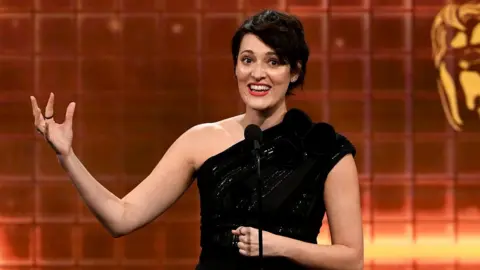Bafta 2020: Do awards exclude women and black actors?
 Getty Images
Getty ImagesThe Baftas have been criticised for a lack of representation after no non-white actors were nominated, and no women were nominated in the best director category for the seventh year in a row.
This comes a day after the Golden Globes had an all-male list of best director nominees.
Bafta boss Amanda Berry said she was "very disappointed" by the lack of diversity.
So, how bad is it?
Ms Berry did point to female directors being nominated in other categories, for example for short films.
Over the past decade only about 5% of Bafta nominations for best actor, actress or best supporting actor or actress were non-white.
That's the Baftas - but what about the rest of the industry?
Gender representation
Martha Lauzen, director of the Center for the Study of Women in Television and Film, at San Diego State University, has been tracking women's employment in the film industry since 1998.
In 2019, just 13% of directors on the 250 highest-grossing films were female, her report on the "celluloid ceiling" found.
And, on these top 250 films, women made up:
- 19% of writers
- 27% of producers
- 21% of executive producers
- 23% of editors
- 5% of cinematographers
Although these figures represent "recent historic highs", there hasn't been a great deal of movement during the 22 years Dr Lauzen has conducted the study.
For comparison, in 1998, on the top 250 films, women made up 9% of directors and:
- 13% of writers
- 24% of producers
- 18% of executive producers
- 20% editors
- 4% of cinematographers
Looking just at the 100 highest-grossing films, the proportion of female directors tripled between 2018 and 2019, from 4% to 12% - but the figures remain low.
Ms Lauzen told advocacy group Women and Hollywood it was "odd to talk about reaching historic highs when women remain so far from parity".
And although the numbers had "moved in a positive direction... men continue to outnumber women four to one in key behind-the-scenes roles".
The Women and Hollywood site's news editor, Rachel Montpelier, also pointed out "there was no change in the number of women working in key off-screen roles since 2018".
Meanwhile, research commissioned by Directors UK, the professional association of UK screen directors, found on 2,591 UK films released between 2005 and 2014, 13.6% of directors were women.
UK film students are broadly 50% male and 50% female, according to the research, and as students enter the industry, the split is also about half and half. So it is as they progress further that the problem emerges.
The report, published in 2016, suggested men were more likely to hire other men, while a lack of female role models may make it harder for women to progress, sustaining the "outdated, unconscious bias of the individuals within the industry".
A report looking at seven European countries including the UK found a similar drop-off in representation: in 2013, 44% of graduates entering the film industry were women, compared with 24% of working directors.
'White males in Hollywood'
A study published last year by the University of California, Los Angeles (UCLA) also looked at ethnic diversity in Hollywood.
 Getty Images
Getty ImagesIt found that, of the 200 highest-grossing films in 2017, 12.6% had a non-white director.
Just 7.8% of the top films' writers were from a non-white background, despite making up 40% of the US population.
These figures are more or less unchanged since 2011 when the first UCLA study was carried out.
In 2017, 19.8% of lead actors were from an ethnic minority background, almost doubling from 10.5% in 2011.
The study said that: "from studio board rooms and executive suits to the talent agencies that act as gatekeepers, the fundamental relations of production that centre white males in Hollywood moviemaking remain largely intact".
It said diverse groups were still "woefully underrepresented" among directors, writers and lead actors.



